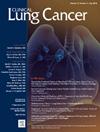Brief Report: Methylation-Based ctDNA Serial Monitoring Correlates With Immunotherapy Response in NSCLC
IF 3.3
3区 医学
Q2 ONCOLOGY
引用次数: 0
Abstract
Purpose
Circulating tumor DNA (ctDNA) can reflect the genetic and epigenetic composition of malignancies and can serve as a noninvasive biomarker for cancer diagnostics and monitoring. This study aimed to evaluate the utility of a methylation-based ctDNA assay as a predictive tool in non-small cell lung cancer (NSCLC) anti-PD1 based immunotherapy monitoring.
Methods
We evaluated a cohort of 20 patients with NSCLC treated with anti-PD1 based immunotherapy that had both baseline and follow-up blood draws as well as outcome data available. Tumor Methylation Scores (TMS) were measured with an amplicon-based, multiplexed cfDNA assay that utilizes quantitative counting templates (QCTs) in conjunction with next-generation sequencing to count the number of methylated molecules at more than 500 genomic locations that are hypermethylated in cancer tissue. The association between TMS and real-world progression-free survival (rwPFS) on therapy was conducted using Cox proportional hazards model and plotted using the Kaplan-Meier method.
Results
The change in TMS measured 4-10 weeks post-treatment initiation strongly correlated with immunotherapy response, as measured by rwPFS (P < 0.0001), compared to a weaker correlation of imaging RECIST v1.1 measurements with rwPFS (P = 0.55). Furthermore, TMS tracked with tumor burden on therapy in real-world cases.
Conclusions
In this real-world dataset of NSCLC patients treated with anti-PD1 immunotherapy regimens, the TMS score measured within a 4-10 week window after treatment initiation can be predictive of response to therapy. Beyond this window, the TMS score can be associated with rwPFS and tumor dynamics. Early evidence suggests that changes in the methylation profile may be informative for monitoring occurrence of new somatic mutations. The cases presented demonstrate the application of using TMS for serial therapeutic response monitoring.
简要报告:基于甲基化的ctDNA序列监测与非小细胞肺癌的免疫治疗反应相关。
目的:循环肿瘤DNA (ctDNA)能反映恶性肿瘤的遗传和表观遗传组成,可作为肿瘤诊断和监测的无创生物标志物。本研究旨在评估基于甲基化的ctDNA检测作为非小细胞肺癌(NSCLC)基于抗pd1免疫治疗监测的预测工具的效用。方法:我们评估了一组20例接受基于抗pd1的免疫治疗的非小细胞肺癌患者,这些患者有基线和随访抽血以及可用的结果数据。肿瘤甲基化评分(TMS)是通过基于扩增子的多重cfDNA分析来测量的,该分析利用定量计数模板(qct)和下一代测序来计算癌症组织中超过500个基因组位置的高甲基化分子的数量。采用Cox比例风险模型并使用Kaplan-Meier方法绘制TMS与治疗后真实无进展生存期(rwPFS)之间的关系。结果:rwPFS测量的治疗开始后4-10周TMS的变化与免疫治疗反应密切相关(P < 0.0001),而成像RECIST v1.1测量与rwPFS的相关性较弱(P = 0.55)。此外,经颅磁刺激还追踪了真实病例的肿瘤治疗负荷。结论:在这个接受抗pd1免疫治疗方案的非小细胞肺癌患者的真实数据集中,治疗开始后4-10周窗口内测量的TMS评分可以预测对治疗的反应。在此窗口之外,TMS评分可以与rwPFS和肿瘤动力学相关。早期证据表明,甲基化谱的变化可能为监测新的体细胞突变的发生提供信息。这些病例展示了经颅磁刺激在连续治疗反应监测中的应用。
本文章由计算机程序翻译,如有差异,请以英文原文为准。
求助全文
约1分钟内获得全文
求助全文
来源期刊

Clinical lung cancer
医学-肿瘤学
CiteScore
7.00
自引率
2.80%
发文量
159
审稿时长
24 days
期刊介绍:
Clinical Lung Cancer is a peer-reviewed bimonthly journal that publishes original articles describing various aspects of clinical and translational research of lung cancer. Clinical Lung Cancer is devoted to articles on detection, diagnosis, prevention, and treatment of lung cancer. The main emphasis is on recent scientific developments in all areas related to lung cancer. Specific areas of interest include clinical research and mechanistic approaches; drug sensitivity and resistance; gene and antisense therapy; pathology, markers, and prognostic indicators; chemoprevention strategies; multimodality therapy; and integration of various approaches.
 求助内容:
求助内容: 应助结果提醒方式:
应助结果提醒方式:


